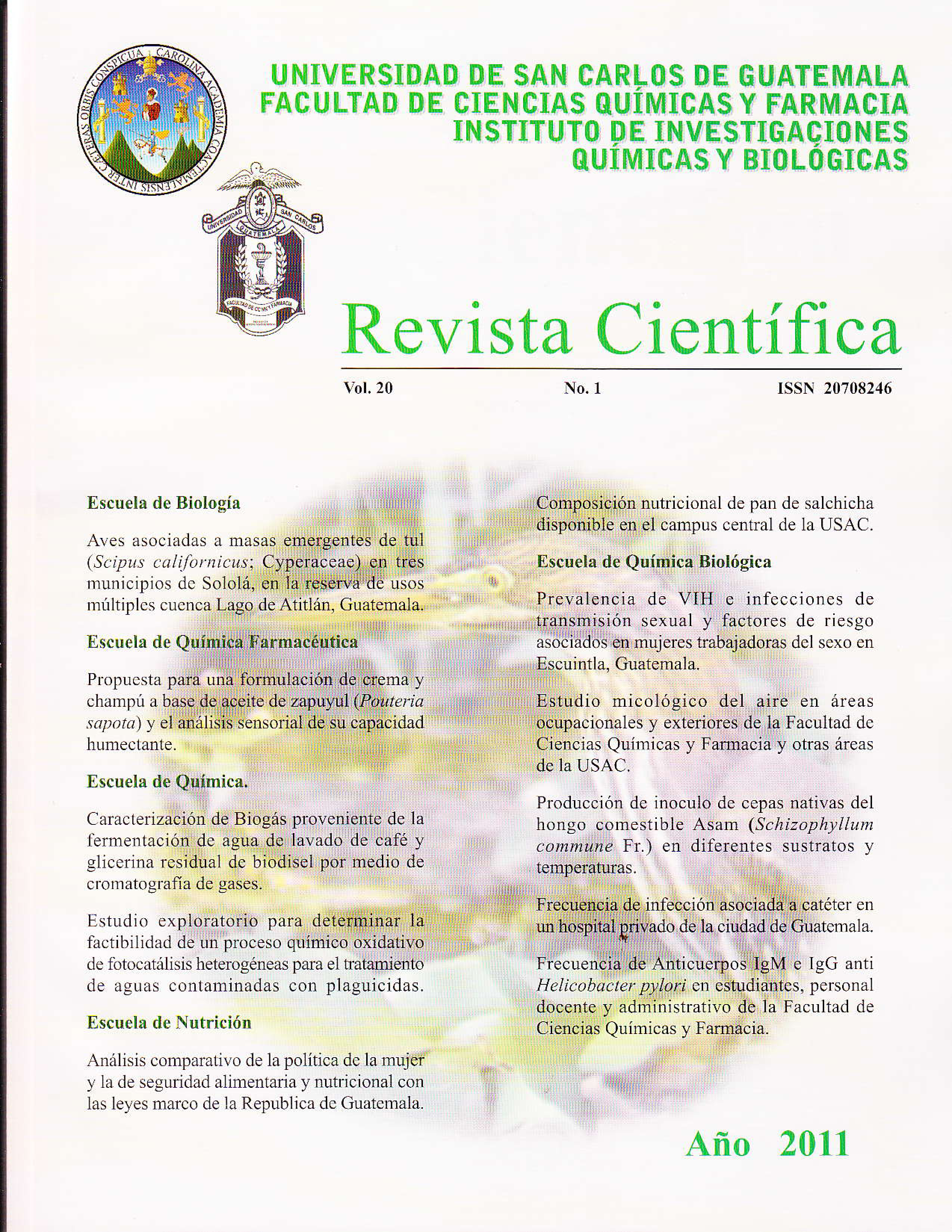Mythological study of the air in occupational and outdoor areas of the Faculty of Chemical Sciences and Pharmacy and other areas of the University of San Carlos de Guatemala.
DOI:
https://doi.org/10.54495/Rev.Cientifica.v20i1.146Keywords:
Aerobiology, microscopic fungi, fungal load, aeroscope, predominant genres, occupational healthAbstract
There are few studies conducted on the aerobiology of tropical countries; therefore, there is a lack of information on the subject. The purpose of this study was to conduct an analysis on the distribution of airborne of microscopic fungi in the atmosphere during the months of February through august 2008. Eight places were sampled, seven were located at San Carlos University of Guatemala (Laboratorio Microbiológico de Referencia -LAMIR-, Laboratorio de Investigación de Productos Naturales -LIPRONAT- , Decanato, the Food Laboratory, Instituto de nvestigaciones Químicas y Biológicas - 11QB- , University direction building and the Central library and the Centro de información y atención toxicological -CIAT- , that was located outside, zone 1. Samples were feken in order to select the hour with the highest fungical load in the air and seven monthly subsequentially samplings were taken. An Eco MAS 100 aeroscope and Saboraud agar + NaCl 7.5% were used for sampling and in each location three samples were taken. The results were that 44% of the samples showed higher concentration of emerging colonies during the morning and the 56% of the samples showed higher concentration during the afternoon. The locations with the highest load were LIPRONAT, the food laboratory and IIQB. The values of the measurements showed that these places are biohazard risks. The place with the lowest fungical load in the study was ClAT. The most frequent generas isolated and characterized were Cladosporium , it was predominant during dry season, and Penicillum. Asperguillus and Manila were predominant during the rainy day season. Yeast. Trichosporum and Rhodotorida were predominant during dry season.
Downloads
References
Bueno, D.; Silva, J. y Oliver, G. (2003). Hongos ambientales en una biblioteca: un año de estudio. Anales d e documentación N 6 . p. 27-34.
Eagle Industrial Higiene Associates. (2004) Microbial Sampling and Analysis: molds and bacteria. http://www.eagleih.com/micro.html. Autor.
García, M. y Uruburu, F. (2000). La conservación de cepas microbianas. Actualidad SEM; 30:12-6.
Harrison. J; Faragher E y Lawton L. (1992). An investigation of the relationship between microbial and particulate indoor air pollution and the sick building syndrome. Respire Med; 86: 225-35, https://doi.org/10.1016/S0954-6111(06)80060-0 DOI: https://doi.org/10.1016/S0954-6111(06)80060-0
Horner, W; Helbling A; Salvaggio J. y Lehrer S. (1995). Fungal allergens. Clin Microbiol Rev 8: 161-79, https://doi.org/10.1128/CMR.8.2.161 DOI: https://doi.org/10.1128/CMR.8.2.161
Klanova, K. (2000). The concentrations of mixed populations of fungi in indoor air: rooms with and without mould problems rooms with and without health complaints. Cent. Bur. J. Public. Health. 8: 59-61.
Lacey, J. (1981). Biology of Conidial Fungi. Academic Press. Vol. 1:376, https://doi.org/10.1016/B978-0-12-179501-6.50020-X DOI: https://doi.org/10.1016/B978-0-12-179501-6.50020-X
Medina, L. y Tuozzo. R. (1999). Estudio de hongos en bibliotecas de la universidad d e Carabobo-Valencia. Vol. 3, No. 1; 1-17.
Organización Mundial de la Salud. ( 1997). Guía para la calidad del aire. Trad: Centro Panamericano de Ingeniería Sanitaria y Ciencias del Ambiente (CEPIS/OPS). Ginebra Suiza. Autor.
Pouch Downes, F & Ito, K. eds. (2001). Compendium of Methods for The Microbiological Examination of Foods. American Public Health Association. Washington, https://doi.org/10.2105/9780875531755 DOI: https://doi.org/10.2105/9780875531755
Rainer J: Pcintner U. y Póder R. (2001). Biodiversity and concentration of airborne fungi in a hospital envir onmen t. Mycopathologia. 149:87-97, https://doi.org/10.1023/A:1007273131130 DOI: https://doi.org/10.1023/A:1007273131130
Reynolds, S; Streifel, A. y Me Jilton, C. (1990). Elevated airborne concentrations of fungi in residential and office environments. American Industrial Association Journal, Vol. 51 , pp. 601-604, https://doi.org/10.1080/15298669091370185 DOI: https://doi.org/10.1080/15298669091370185
Rojas, T. y Martínez E. (2000). Monitoreo microbiano del aire: Criterios metodológicos. Contribución a la educación y protección ambiental. Vol. 1: 110-115. VI Taller d e la Cátedra de Medio Ambiente.
Rosas. I.; Calderón,C.; Martínez, L.; Ulloa, M. y Lacey, J.(1997). Indoor and outdoor airborne fungal propaule concentration in Mexico City Aerobiologia, 13: 13-23, https://doi.org/10.1007/BF02694787 DOI: https://doi.org/10.1007/BF02694787
Suárez, V. y Lancha. M. (2004), Identificación de levaduras de exudados vaginales: características clínicas asociadas a la candidiasis. Universidad de Carabobo Núcleo Aragua. Venezuela. Instituto de Medicina Tropical "Pedro Kourí’’. Rev Cubana Med Trap vol.56 no.l Ciudad de la Habana
Downloads
Published
How to Cite
Issue
Section
License
Copyright (c) 2011 K. Herrera, O. Cóbar, J. De León, M. García, S. Boburg, R. López, A. Marroquin, M. Marroquin, E. Solis

This work is licensed under a Creative Commons Attribution 4.0 International License.
Authors who publish with this journal agree to the following terms:
- Authors retain copyright and grant the journal right of first publication with the work simultaneously licensed under a Creative Commons Attribution License 4.0 that allows others to share the work with an acknowledgement of the work's authorship and initial publication in this journal.
- Authors are able to enter into separate, additional contractual arrangements for the non-exclusive distribution of the journal's published version of the work (e.g., post it to an institutional repository or publish it in a book), with an acknowledgement of its initial publication in this journal.
- Authors are permitted and encouraged to post their work online (e.g., in institutional repositories or on their website) prior to and during the submission process, as it can lead to productive exchanges, as well as earlier and greater citation of published work.









